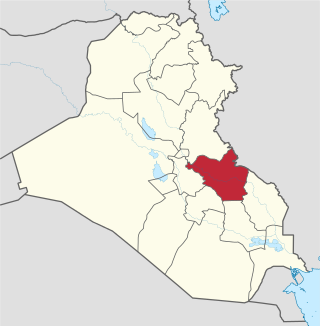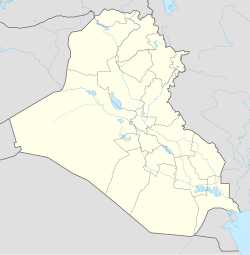
Wasit Governorate is a governorate in eastern Iraq, south-east of Baghdad and bordering Iran. Prior to 1976 it was known as Kut Province. Major cities include the capital Al-Kut, Al-Hai and Al-Suwaira. The governorate contains the Mesopotamian Marshes of Shuwayja, Al-Attariyah, and Hor Aldelmj. Its name comes from the Arabic word meaning "middle", as the former city of Wasit lay along the Tigris about midway between Baghdad and Basra. Wasit city was abandoned after the Tigris shifted course.

Wasit was an early Islamic city in Iraq. It was founded in the 8th century by the Umayyad viceroy of Iraq, al-Hajjaj ibn Yusuf, to serve as the region's seat and as the garrison of the Syrian troops who enforced Umayyad rule there. It was situated between the two traditional administrative centers and garrisons of Iraq, Kufa and Basra, hence its name Wasit. The city was abandoned centuries later and its ruins are located in the eponymous Wasit Governorate, southeast of Kut in southeastern Iraq.
Al Qunfudhah, also known as Kunfuda, is a Saudi city in the Tihamah region on the coast of the Red Sea. Its population is the fourth largest in Makkah Province, the area of the governate is estimated at 5,195 km², which occupies about 3.65% of the area of the region and is ranked ninth among the governorates of the region in terms of area. It is also one of the large sea ports of the Kingdom of Saudi Arabia on the Red Sea. Al Qunfudhah was founded in 1311 A.C-709 Hijri according to the ancient sources.

San Pietro al Tanagro is a village and comune in the province of Salerno in the Campania region of south-west Italy.
An-Nu'mānīyah is a city on the Tigris river in Iraq, located roughly 140 kilometres (87 mi) southeast of Baghdad in the Wasit Province. It is the site of one of four national training centers for the Iraqi Army.

Multinational Division Central-South (MND-CS), created in September 2003, and supported by NATO, was a part of the Multinational Force Iraq. Headquartered in Camp Echo, it was under Polish command until October 2008, when the last of Poland's troops were withdrawn. The Polish contingent was its largest. Other participants included Armenia, Bosnia and Herzegovina, Bulgaria, Denmark, Kazakhstan, Latvia, Lithuania, Mongolia, Norway, Romania, El Salvador, Slovakia, Spain, Ukraine and the United States of America. As of December 2008, Armenian, Bosnian, Danish, Latvian, Kazakh, Lithuanian, Mongolian, Spanish and Slovakian forces had been fully withdrawn.
Abū ‘Amr ‘Uthmān ibn ‘Abd il-Raḥmān Ṣalāḥ al-Dīn al-Kurdī al-Shahrazūrī, commonly known as Ibn al-Ṣalāḥ, was a Kurdish Shafi'i hadith specialist and the author of the seminal Introduction to the Science of Hadith. He was born in the village of Shahrakhan in Erbil, Kurdistan and was raised in Mosul and then resided in Damascus, where he died.
Al-Hai District is a district of the Wasit Governorate, Iraq. Its seat is the city of Al-Hay.
Al-Suwaira District is part of the Wasit Governorate in eastern Iraq and is about 35 km south-east of Baghdad. The Tigris runs through it. Famous for its fruit and palm orchards, its seat is the city of Al-Suwaira. Shaykh Mazhar Air Base is roughly 13 km west of the city of Al-Suwaira.
Al-Mada'in District is a district of the Baghdad Governorate, Iraq. It includes the city of Salman Pak, which incorporates the ancient ruins of Al-Mada'in, and the oldest freestanding mud brick arch in the world. Other metropolitan areas include Jisr Dyala, an urban district that borders the Baghdad city district of (???), the northern village of Nahrawahn with its major brickworks, and the central village of Wahedah that sits astride the Basrah Highway into Wasit Province.

Abū al-Husayn Bajkam al-Mākānī, referred to as Bajkam, Badjkam or Bachkam, was a Turkish military commander and official of the Abbasid Caliphate. A former ghulam of the Ziyarid dynasty, Bajkam entered Abbasid service following the assassination of the Ziyarid ruler Mardavij in 935. During his five-year tenure at the Caliphate's court at Baghdad, he was granted the title of amir al-umara, consolidating his dominance over the caliphs al-Radi and al-Muttaqi and giving him absolute power over their domains. Bajkam was challenged throughout his rule by various opponents, including his predecessor as amir al-umara, Muhammad ibn Ra'iq, the Basra-based Baridis, and the Buyid dynasty of Iran, but he succeeded in retaining control until his death. He was murdered by a party of Kurds during a hunting excursion in 941, shortly after the accession of al-Muttaqi as Caliph. Bajkam was known both for his firm rule and for his patronage of Baghdad intellectuals, who respected and in some cases befriended him. His death led to a void in central power, resulting in a brief period of instability and fighting in Baghdad.
Yazid ibn Umar ibn Hubayra al-Fazari was the last Umayyad governor of Iraq. A son of former governor Umar ibn Hubayra, he became one of the most important partisans of Caliph Marwan II in the Third Fitna, but failed to stem the onslaught of the Abbasid Revolution. Defeated, he was captured and executed by the Abbasids after the Siege of Wasit.
Abu'l-Wafa Tuzun, commonly known as Tuzun, was a Turkish soldier who served first the Iranian ruler Mardavij ibn Ziyar and subsequently the Abbasid Caliphate. Rising to a position of leadership in the Abbasid army, he evicted the Hamdanid Nasir al-Dawla from Baghdad and assumed the position of amir al-umara on 31 May 943, becoming the Caliphate's de facto ruler. He held this position until his death in August 945, a few months before Baghdad, and the Abbasid Caliphate with it, came under the control of the Buyids.
Al-Suwaira is a city in Al-Suwaira District, Wasit Governorate, Iraq. It is located on the west bank of the Tigris, 35 km south of Baghdad. It is surrounded by fruit groves and palm orchards. It has a population of 77,200, predominantly Shia Arabs.
Abu Abdallah al-Hasan al-Baridi was the most prominent of the Baridi family, Iraqi tax officials who used the enormous wealth gained from tax farming to vie for control of the rump Abbasid Caliphate in the 930s and 940s.

Al-Aziziyah is an Iraqi town located in Wasit Province, on the left bank of the Tigris River. Located approximately 80 kilometers northwest of Kut, it is the administrative and political centre of Al-Aziziyah District. As of 2009, it had an estimated population of 44,868 citizens.

Al-Numaniya Sport Club, is an Iraqi football team based in Al-Nu'maniya District, Wasit, that plays in the Iraqi First Division League.
Kordali (Kurdali), or Pahlavi, is one of the Kurdish languages. It is often included in Southern Kurdish, but is quite distinct. It is spoken by the large Kordali tribe in the borderlands between Iraq and Iran.
Tulul al-Baqarat or Tulūl al-Baqarāt, is an ancient Near East archaeological site in Wasit Governorate of Iraq about 180 kilometers southeast of modern Baghdad. It is located seven kilometers to the northeast of Tell al-Wilayah and 20 kilometers south of the city of Kut. The site was occupied from the 4th millennium BC to the Islamic period. It is thought to be the site of the ancient Early Dynastic city of Kesh.
Thulth al-Wasit is a sub-district located in Kharif District, 'Amran Governorate, Yemen. Thulth al-Wasit had a population of 2153 according to the 2004 census.









